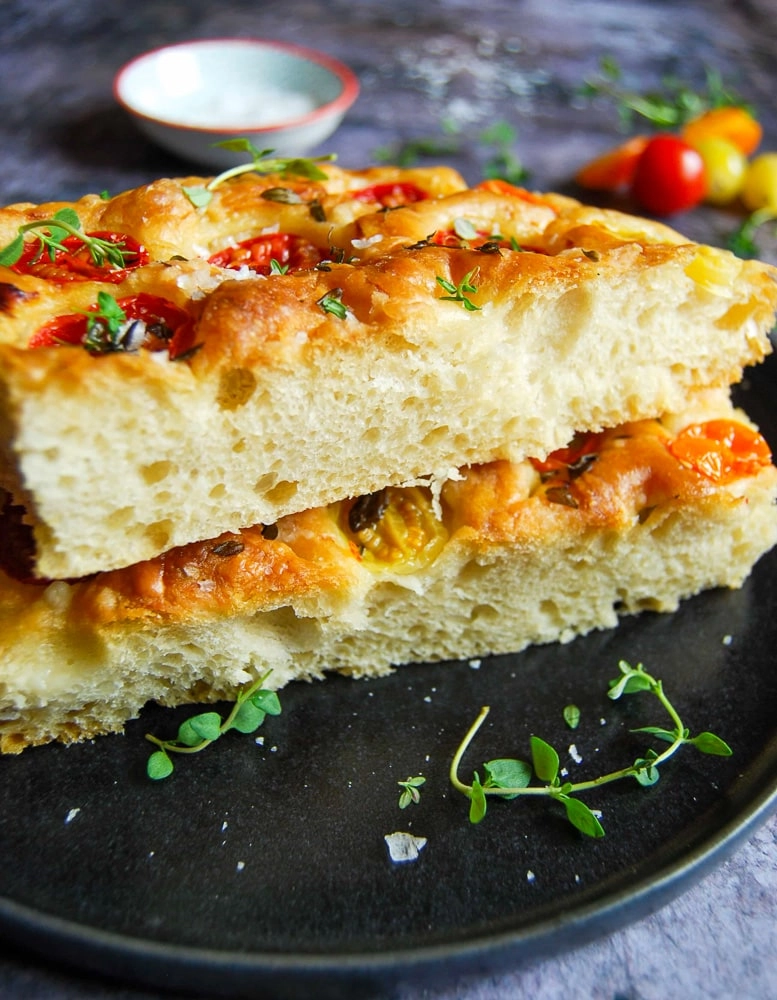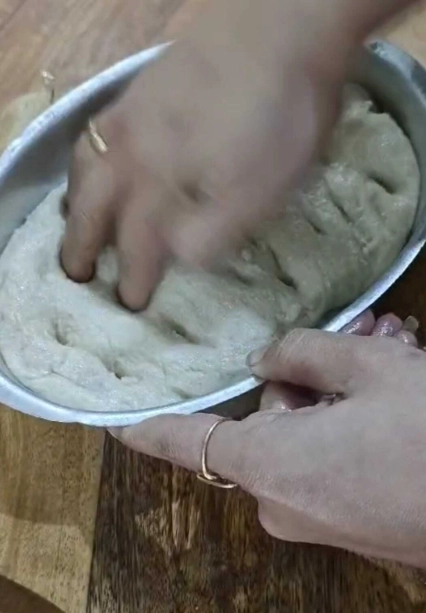There’s a moment when the dough comes together—when your hands press into the soft, warm texture and the air begins to smell like something deeply comforting. It’s a moment I know so well, one that has been part of my life for as long as I can remember. Focaccia bread isn’t just a recipe for me; it’s a thread that ties me to my past, to my family, and to a world that’s been shaped by love, patience, and the comforting embrace of good food.
As a child, I spent countless hours in my grandmother’s kitchen, watching her move effortlessly through the process of making focaccia. She didn’t need to measure anything her hands, seasoned with years of baking, just knew. The flour, the water, the yeast, and a generous glug of olive oil she added them with a kind of reverence, like she was sharing a secret with the dough. I would stand by her side, fascinated by the way her hands worked the dough, turning it from a simple mixture of ingredients into something magical.
Focaccia, for us, was never just a bread. It was an invitation to slow down, to savor the small moments that we often overlook. It was our way of saying, "We’re here. Let’s be present. Let’s share something beautiful together."
The Rhythm of Bread-Making
If I close my eyes, I can still hear my grandmother’s voice in the kitchen. She would hum softly as she kneaded the dough, her movements steady and practiced. "You can’t rush bread," she’d say, pressing her fingers into the dough, letting it rise at its own pace. "Just like life, it needs time to grow, to breathe, and to become."
I remember those words as though she was still here, guiding me through the process. And even though I’ve baked focaccia many times on my own now, I still hear her in my mind, urging me to be patient, to trust the dough, and to take my time.
It’s funny how a simple loaf of bread can teach you so much about life. Making focaccia is a reminder that not everything needs to be rushed. Sometimes, it’s in the waiting—the letting go and trusting the process—that we find the most beautiful things.

The Joy of Sharing Focaccia
It was never just about the bread. It was about the people you shared it with. My grandmother’s focaccia always brought our family together. I remember those Sundays, the ones that felt timeless when the kitchen was full of conversation, laughter, and the clinking of dishes. The table would be set with simple, fresh ingredients—olive oil, balsamic vinegar, perhaps a few slices of cheese—and of course, the focaccia, still warm from the oven, its golden crust glistening with olive oil and sprinkled with rosemary.
We would tear off pieces of the bread, the smell of rosemary and garlic filling the air, passing it around the table, not needing words to say how much we appreciated each other. It was in the quiet moments—sharing a piece of bread, eyes meeting across the table—that I learned what family really meant. Focaccia became a symbol of togetherness, of slow meals, of time spent without hurry. It was a way of being present, of showing up for the people you love.

Now, when I bake focaccia in my own kitchen, it’s not just about making something to eat. It’s about creating a space for memories, for connection. When my own children come in from school, the smell of the bread fills the house, and they immediately know something special is happening. They gather around, excited to help me press the dough, sprinkle the rosemary, to feel the warmth of the kitchen and the joy of being part of something bigger than themselves.
Focaccia is that kind of bread. It’s meant to be shared. It’s the bread that tells stories and builds bonds. It’s the kind of bread that turns an ordinary meal into a celebration.

A Recipe That Speaks to the Heart
For me, the process of making focaccia is more about the feelings it stirs up than the exact measurements. It’s about the touch of the dough, the way it feels soft and supple in your hands, almost like it’s alive. It’s about the quiet anticipation as the dough rises, the joy of pressing your fingers into it to create those perfect dimples. And it’s about the satisfaction of watching it transform in the oven, golden brown and crisp, just waiting to be shared.
So, if you’re ready to make your own focaccia, remember—it’s not just about following a recipe. It’s about slowing down, being present, and allowing the bread to be part of something bigger than you. Here’s how you can bring a little bit of love and tradition into your own kitchen:
Ingredients:
500g (about 4 cups) all-purpose flour
325ml (about 1 1/3 cups) warm water
2 teaspoons dry instant yeast
2 tablespoons olive oil (plus extra for drizzling)
1 tablespoon sea salt
Fresh rosemary (or your favorite herbs)
Optional: olives, cherry tomatoes, garlic, or caramelized onions for toppings
Instructions:
Mix the Dough: In a large bowl, combine the flour, salt, yeast, sugar, and olive oil, stirring until the dough comes together. Don’t rush it—let the dough reveal itself slowly, just as life does.
Knead the Dough: Turn the dough onto a floured surface and knead for 10 minutes, feeling the dough become smoother with every fold. This is your time to connect with the dough, to let go of any stress or hurry, and just enjoy the rhythm of your hands at work.
First Rise: Place the dough in a lightly oiled bowl and cover it with a cloth. Let it rise for 1-2 hours. Use this time to reflect, breathe, and be present in the moment.
Shape the Dough: Punch the dough down gently and transfer it to a baking sheet. Spread it out with your fingers, pressing down to create dimples. It’s the little details like this that make the bread special—just as it’s the little moments in life that matter most.
Second Rise: Let the dough rise for another 30 minutes while you preheat your oven to 400°F (200°C). Don’t rush it—good things take time.

Top It Off: Drizzle olive oil over the dough and sprinkle with rosemary or any toppings that make you feel at home. Feel free to get creative—this is your bread, after all.
Bake and Enjoy: Bake the focaccia for 20-25 minutes until golden brown. As the bread bakes, the smell will fill your home, creating a sense of warmth and comfort that reminds you of everything that really matters.
Share and Create Memories: Let the focaccia cool slightly, then slice it and serve. Share it with the people you love, or savor a quiet moment with just yourself.

The nutritional information of focaccia bread.
Nutrient | Per Slice (1/12 of a 9x13-inch pan) |
Calories | 150–200 kcal |
Carbohydrate | 25–30 grams |
Fiber | 1–2 grams |
Sugar | 1–3 grams |
Protein | 3–4 grams |
Fat | 5–10 grams |
Saturated Fat | 1–2 grams |
Cholesterol | 0–10 mg |
Sodium | 250–350 mg |
Potassium | 100–150 mg |
Calcium | 20–30 mg |
Iron | 1–2 mg |
This table breaks down all the major nutrients in a simple, at-a-glance format. It gives you a clear picture of what’s in a slice of focaccia, making it easier to decide how it fits into your day!
Focaccia: More Than Just Bread
In the end, focaccia is more than just a loaf of bread. It’s a reminder to slow down, to savor the simple moments, and to be present with the people you care about. It’s about connection—whether it’s with family, friends, or even yourself. Every time I make focaccia, I’m reminded that food is a way of telling stories, building traditions, and passing on love.
So, next time you make focaccia, think of it as more than just an ingredient list. Think of it as a way to connect with your past, to honor the people who came before you, and to share something beautiful with the ones you love. Because, in the end, focaccia is not just bread. It’s a piece of your heart, shaped by your hands and shared with the world.

FAQs
1. What is focaccia bread?
Focaccia is an Italian flatbread that’s known for its soft, airy texture and crispy, golden crust. It’s often topped with olive oil, sea salt, and herbs like rosemary, but you can get creative with toppings like olives, garlic, or tomatoes. Focaccia is versatile and can be served as a snackside dish, or even used for sandwiches.
2. Do I need a bread machine to make focaccia?
Nope! While a bread machine can make the process easier, you can absolutely make focaccia by hand. All you need is some time and patience to knead the dough and allow it to rise. The hands-on experience is what makes it even more special.
3. How long does it take to make focaccia?
Making focaccia takes a few hours because of the rising times, but the active work is relatively short. The dough usually needs about 1 to 2 hours to rise for the first time, and then a 30-minute rise after shaping it. After that, it bakes for about 20-25 minutes. So, you’ll need about 3 hours in total, but most of it is hands-off time, so you can go about your day!
4. Can I make focaccia without yeast?
Focaccia traditionally uses yeast, which helps it rise and gives it that soft, airy texture. If you're looking to make a yeast-free version, you could try using baking powder or baking soda, but the texture will be different. The bread will be a bit more dense and won’t have the same rise as a yeasted focaccia.
5. How can I make my focaccia extra crispy?
For a crispier crust, make sure to add plenty of olive oil on the top of the dough before baking. This creates a nice, golden, and crispy surface. You can also bake it on a pizza stone or in a cast-iron skillet for even better results.
6. Can I freeze focaccia bread?
Yes! Focaccia freezes beautifully. Once it’s baked and cooled, wrap it tightly in plastic wrap or aluminum foil, and store it in the freezer for up to 3 months. To reheat, you can pop it in the oven at 350°F (175°C) for about 10 minutes until warmed through.
7. What toppings can I put on focaccia?
The possibilities are endless! Traditional toppings include fresh rosemary, sea salt, and garlic, but you can also get creative with toppings like:
Olives (green or black)
Sliced tomatoes
Caramelized onions
Parmesan cheese
Fresh herbs (basil, thyme, etc.)
Roasted garlic or onions
Sundried tomatoes You can also drizzle balsamic vinegar or balsamic glaze after baking for a tangy touch.

8. Why is my focaccia dough not rising?
If your dough isn’t rising, there could be a couple of reasons:
Yeast issues: Make sure your yeast is fresh and activated in warm water (not too hot or cold). If the yeast doesn’t foam up, it’s no longer active.
Too cold environment: Dough rises best in a warm environment. If it’s too cold, it might take longer or not rise at all. Try placing the bowl in a warm, draft-free area (like an oven with just the light on) or covering it with a warm cloth.
Under-kneading: Proper kneading helps the dough develop structure and traps air, allowing it to rise. Make sure you knead it long enough to get a smooth, elastic dough.
9. How can I tell if my focaccia is done?
Your focaccia should be golden brown with a slightly crispy crust. Tap the bottom of the bread; it should sound hollow. If it does, it’s done! If not, put it back in the oven for a few more minutes.
10. Can I use a gluten-free flour blend for focaccia?
Yes! If you're following a gluten-free diet, you can make gluten-free focaccia by substituting all-purpose flour with a gluten-free flour blend. Just keep in mind that gluten-free breads often need additional ingredients, such as xanthan gum or psyllium husk, to give them the proper texture and elasticity. If you're using a pre-made gluten-free flour blend, check if it includes these ingredients.
11. What can I serve with focaccia?
Focaccia is incredibly versatile! Here are a few ideas for serving it:
As a side to soups and salads
Paired with Italian antipasto platters (cheese, olives, prosciutto)
With balsamic vinegar and olive oil for dipping
As a base for sandwiches or paninis
Enjoyed on its own, fresh out of the oven, with a little butter or olive oil
12. How do I store leftover focaccia?
Leftover focaccia can be stored at room temperature for a couple of days. Simply wrap it in a clean kitchen towel or place it in a paper bag to keep it soft. If you want to keep it longer, store it in an airtight container. If you’re keeping it for more than a couple of days, freezing it is the best option.


Comments